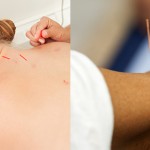Acupuncture – Physiotherapy Classical acupuncture originated ~2250 years ago. It has its history in Traditional Chinese Medicine. Modern “western” acupuncture originated in the 1970s, Western acupuncture was based on modern anatomical knowledge. Acupuncture – Physiotherapy involves the insertion of thin needles into the body at specific points. Because the needles are so thin (1/100th the width of a hypodermic needle), there is very little feeling when they are put in. Many people barely feel it when the needles go into the skin. Most acupuncture points are located on or next to nerves and muscles. Benefits of Acupuncture – Physiotherapy: The introduction of acupuncture needles can reduce pain and inflammation. Acupuncture – physiotherapy can help to restore normal function. Acupuncture can also help reduce stress, anxiety and depression, as well as promote energy and relaxation. Safety Concerns with Acupuncture – Physiotherapy Acupuncture is very safe when performed correctly. Before any acupuncture…
Read More


